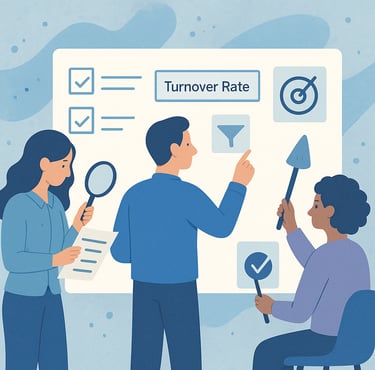Getting Started: Defining Metrics, Cleaning Data & Setting Objectives
Andras Rusznyak
7/29/20254 min read
Ha magyarul szeretnéd olvasni a cikket, kattints ide


Why this foundation matters
In our last article we explained why HR Analytics is a source of strategic value. But before you can analyze or predict anything, your HR data must be clean, consistent, and clearly connected to business objectives. Too many HR analytics efforts fail not because of poor tools or lack of interest—but because the basics were skipped.
In this article, we’ll cover three critical building blocks:
Defining clear, relevant HR metrics
Cleaning and structuring your data
Setting objectives that connect people data to business outcomes
These aren’t glamorous steps—but they’re what makes every great analytics initiative possible.
IMPORTANT NOTE:
We utilized generative AI in the making of this article.
Analytics is not about “having more data.” It’s about answering better questions.
That starts with setting specific goals.
Ask:
What business problem are we trying to solve or understand better?
What decision will this data inform?
Who is the audience for the insight?
Examples of good starting questions:
“Why is turnover higher in one department than others?”
“Are our internal promotions resulting in better performance?”
“Which onboarding practices reduce new hire attrition?”
These questions drive your metric definitions and shape your data strategy.
Start with the end in mind: what do you want to know?
Defining HR metrics that matter
Once you have a clear question, define how you’ll measure it. A good metric is:
Clear: Anyone can understand it
Consistent: Calculated the same way across time and teams
Relevant: Tied to a business need or decision
Here are a few common (and commonly misused) metrics—and better ways to define them:
Turnover Rate = Voluntary leavers ÷ average headcount over the period
Time to Hire = Days between job requisition approval and offer acceptance
Internal Mobility Rate = Internal transfers ÷ total movements (internal + external hires)
Training Completion Rate = % of assigned employees who completed training within X days
First-Year Attrition = % of new hires leaving within 12 months (split voluntary/involuntary if possible)
Tip: Keep a single-source “HR metric glossary” in a shared doc or slide so definitions stay consistent as your team grows.
Cleaning and preparing your HR data
Set objectives and use cases
HR data is often messy: inconsistent titles, outdated info, duplicate entries, missing fields. But without cleaning, even the best analytics models will mislead.
Key data preparation steps:
Standardize job titles and departments: “Software Engineer” vs. “SWE” vs. “Engineer 2” should be aligned.
Remove or flag duplicates: Especially for employees with multiple records across systems.
Handle missing values: For example, replace blank exit dates for active employees with a placeholder, or use “N/A” for departments not assigned.
Check time formats and IDs: Make sure your dates are in standard format and employee IDs don’t conflict.
Start small. Pick 2–3 data sources (e.g. HRIS, LMS, survey platform) and build a simple integrated dataset. Use spreadsheets, SQL, or BI tools—whatever fits your setup.
Pro tip: If you can’t trust your data, no one else will trust your analysis.
Once your data is clean and your metrics are clear, align your analytics with real organizational objectives. This is what moves HR from support function to strategic partner.
Use case examples:
Reduce voluntary turnover in high-performing teams by 15%
Increase internal mobility to 30% of total hires within a year
Shorten onboarding ramp time for sales reps by 20%
Improve completion rate of compliance training to 95% in 3 months
Well-defined objectives help prioritize what to analyze—and how to act on it.
Practical example: Streamlining onboarding to reduce early attrition
Scenario: A tech company is seeing high turnover (22%) among new hires within their first year, especially in engineering.
Step 1 – Set a clear question
“Which onboarding factors correlate with lower first-year attrition in engineering?”
Step 2 – Define relevant metrics
First-Year Attrition Rate = new hires who leave within 12 months ÷ new hires total
Onboarding Completion Rate = % of new hires completing all onboarding steps
Time to First Manager Check-in = average days between hire and first documented 1:1
Step 3 – Prepare the data
Pull data from:
HRIS (hire date, exit date, manager ID)
LMS (onboarding progress, completion timestamps)
Calendar logs (first check-in date)
Cleaned and merged by unique employee ID.
Step 4 – Analyze
Discover:
New hires who completed onboarding + had a 1:1 with their manager within the first 10 days had only 11% attrition.
Those who didn’t complete onboarding or had no check-in in the first month had 28% attrition.
Step 5 – Act
Set a new policy:
Mandatory manager check-in within 10 days of start date
Monitoring via weekly HR report to managers
Quarterly audits of onboarding completion
Result (tracked 6 months later):
First-year attrition in engineering drops from 22% to 15%.
Recruitment savings: estimated $220K.
Manager buy-in improves because they saw clear, credible insights.
Final thoughts: Build trust, not just tools
The best HR analytics teams don’t start with algorithms—they start with well-framed questions, trustworthy data, and useful metrics. These basics may feel slow, but they are the fastest way to long-term impact.
You don’t need to analyze everything. Start small. Get one clean metric tied to one clear objective, and demonstrate its value.
Once you do, the momentum builds—and your HR team becomes not just analysts, but enablers of strategic decisions.
Up next: In the next article, we’ll dive into Descriptive & Diagnostic Insights—showing you how to move from basic reports to real understanding.
Have you read our other articles? Go to Motioo Insights
Do you have any questions or comments? Contact us


